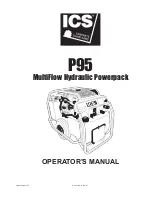
SETUP & PREPARATION
OPERATION
TROUBLESHOOTING
MAINTENANCE
If the air ratchet fails to work effectively, perform the following
checks:
• Check the forward/ reverse lever is set to the correct direction.
• Check that the pressure on the air compressor is within its
||
working range. If not, let the compressor rest to
re-pressurise /
refer to the compressor instruction manual.
•
|
Check to see if the ratchet has become jammed. Air leaks and the
absence of the ratchet sound are indications the air ratchet is
jammed. To correct, lightly tap the head of the ratchet on the
ground or working surface. Alternatively, toggle the forward/
reverse lever.
Note: Disconnect the tool from the air supply before attaching or removing accessories.
Note: This tool is rated at 90psi. Ensure your compressor is set no higher than 90psi.
Note: The air ratchet should only be
used with impact sockets. Standard
sockets may shatter and break.
F
R
3. Screw the male nitto fitting
clockwise into the female end of
the ratchet.
4. Pull back the sleeve on hose
fitting, insert male ratchet end &
release sleeve on hose fitting.
5. Place the 4 sided open end of a
1/2” drive socket onto the ratchet.
1. Remove black plastic cap from
air inlet.
2. Wrap the threaded male end with
teflon tape in a clockwise direction.
2. Select the direction of rotation
by turning the forward/reverse lever
anti-clockwise for forward or
clockwise reverse rotation.
1. To turn the air ratchet on, squeeze
the on/off trigger. Release to turn off.
3. After each use, place one drop
of oil into the ratchet, through the
air inlet.
• Keep the ventilation vents of the ratchet clean at all times, if
possible, prevent foreign matter from entering the vents.
• If the enclosure of the ratchet requires cleaning, do not use
solvents but a moist soft cloth only. Never let any liquid get inside
the ratchet ; never immerse any part of the ratchet into a liquid.
• Oil the ratchet after each use.




















